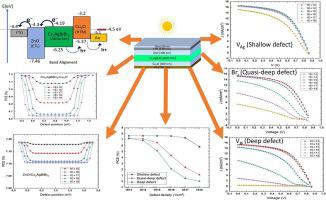当前位置:
X-MOL 学术
›
Comp. Mater. Sci.
›
论文详情
Our official English website, www.x-mol.net, welcomes your
feedback! (Note: you will need to create a separate account there.)
Simulation studies to quantify the impacts of point defects: An investigation of Cs2AgBiBr6 perovskite solar devices utilizing ZnO and Cu2O as the charge transport layers
Computational Materials Science ( IF 3.1 ) Pub Date : 2020-11-01 , DOI: 10.1016/j.commatsci.2020.109865 Tohidul Islam , Rafsun Jani , Syed Muhammad Al Amin , Kazi Md Shorowordi , Sadiq Shahriyar Nishat , Alamgir Kabir , M.F.N. Taufique , Shaestagir Chowdhury , Sankha Banerjee , Saquib Ahmed
Computational Materials Science ( IF 3.1 ) Pub Date : 2020-11-01 , DOI: 10.1016/j.commatsci.2020.109865 Tohidul Islam , Rafsun Jani , Syed Muhammad Al Amin , Kazi Md Shorowordi , Sadiq Shahriyar Nishat , Alamgir Kabir , M.F.N. Taufique , Shaestagir Chowdhury , Sankha Banerjee , Saquib Ahmed

|
Abstract In this investigation, we have applied SCAPS and wxAMPS to simulate defects and probe a photovoltaic device utilizing Cs2AgBiBr6 as the active photovoltaic layer and ZnO and Cu2O as the electron transport layer (ETL) and hole transport layer (HTL) respectively. At the Cs2AgBiBr6 bulk we find that with increasing defect density, each defect level has increasing impact on all device performance parameters. At a given defect density however, we find that that deeper defects have more profound impacts on Jsc and FF, and minimal effects on Voc. Specific to the Cs2AgBiBr6 structure, we have investigated VAg (shallow defect), VBi (deep defect) and Bri (quasi-deep defect). Our results provide insight into the growth conditions of Cs2AgBiBr6, with a need to have both Br-poor and Bi-rich conditions, and a preference for the latter over the former to suppress the deeper defect. Exploring the performance kinetics at the ZnO/Cs2AgBiBr6 and Cs2AgBiBr6/Cu2O interfaces due to defect type, location and density, we showcase a remarkably stable behavior in both Voc and Jsc across both interfaces. We attribute this to much higher charge mobilities in the ZnO and Cu2O compared to the Cs2AgBiBr6 layer combined with similar defect densities across the layers, leading to effective charge extraction and minimal charge recombination.
中文翻译:

量化点缺陷影响的模拟研究:利用 ZnO 和 Cu2O 作为电荷传输层的 Cs2AgBiBr6 钙钛矿太阳能器件的研究
摘要 在这项研究中,我们应用 SCAPS 和 wxAMPS 来模拟缺陷并探测利用 Cs2AgBiBr6 作为活性光伏层,ZnO 和 Cu2O 作为电子传输层 (ETL) 和空穴传输层 (HTL) 的光伏器件。在 Cs2AgBiBr6 块体中,我们发现随着缺陷密度的增加,每个缺陷级别对所有器件性能参数的影响都越来越大。然而,在给定的缺陷密度下,我们发现更深的缺陷对 Jsc 和 FF 的影响更深远,而对 Voc 的影响最小。针对 Cs2AgBiBr6 结构,我们研究了 VAg(浅缺陷)、VBi(深缺陷)和 Bri(准深缺陷)。我们的结果提供了对 Cs2AgBiBr6 生长条件的洞察,需要同时具有贫溴和富铋条件,并且倾向于后者而不是前者以抑制更深的缺陷。由于缺陷类型、位置和密度,探索了 ZnO/Cs2AgBiBr6 和 Cs2AgBiBr6/Cu2O 界面的性能动力学,我们展示了两个界面上 Voc 和 Jsc 的非常稳定的行为。我们将此归因于与 Cs2AgBiBr6 层相比,ZnO 和 Cu2O 中的电荷迁移率要高得多,并且各层之间具有相似的缺陷密度,从而导致有效的电荷提取和最小的电荷复合。
更新日期:2020-11-01
中文翻译:

量化点缺陷影响的模拟研究:利用 ZnO 和 Cu2O 作为电荷传输层的 Cs2AgBiBr6 钙钛矿太阳能器件的研究
摘要 在这项研究中,我们应用 SCAPS 和 wxAMPS 来模拟缺陷并探测利用 Cs2AgBiBr6 作为活性光伏层,ZnO 和 Cu2O 作为电子传输层 (ETL) 和空穴传输层 (HTL) 的光伏器件。在 Cs2AgBiBr6 块体中,我们发现随着缺陷密度的增加,每个缺陷级别对所有器件性能参数的影响都越来越大。然而,在给定的缺陷密度下,我们发现更深的缺陷对 Jsc 和 FF 的影响更深远,而对 Voc 的影响最小。针对 Cs2AgBiBr6 结构,我们研究了 VAg(浅缺陷)、VBi(深缺陷)和 Bri(准深缺陷)。我们的结果提供了对 Cs2AgBiBr6 生长条件的洞察,需要同时具有贫溴和富铋条件,并且倾向于后者而不是前者以抑制更深的缺陷。由于缺陷类型、位置和密度,探索了 ZnO/Cs2AgBiBr6 和 Cs2AgBiBr6/Cu2O 界面的性能动力学,我们展示了两个界面上 Voc 和 Jsc 的非常稳定的行为。我们将此归因于与 Cs2AgBiBr6 层相比,ZnO 和 Cu2O 中的电荷迁移率要高得多,并且各层之间具有相似的缺陷密度,从而导致有效的电荷提取和最小的电荷复合。











































 京公网安备 11010802027423号
京公网安备 11010802027423号